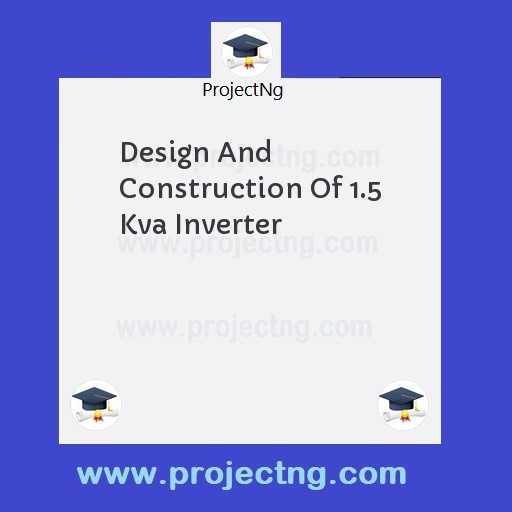Design And Construction Of 1.5 Kva Inverter
Electrical/electronic Engineering Project Topics
Get the Complete Project Materials Now! »
DESIGN AND CONSTRUCTION OF 1.5 KVA INVERTER
CHAPTER ONE
1.1. INTRODUCTION
Currently almost all the inverters available in the market use the PWM (Pulse Width Modulation) technology. PWM based inverters are superior in many ways compared to the inverters based on traditional technology. PWM based inverters use MOSFET devices in-its output section. So, these inverters are also known as PWM MOSFET inverter. These PWM MOSFET inverters contain many protection circuits to protect the inverter, inverter battery, load at the inverter output and the user from various fault conditions. Some of the special control/protection circuits used in the PWM MOSFET inverter are:
• Battery charging current sensing circuit
• Battery voltage sensing circuit
• AC mains sensing circuit
• Soft start circuit
• Low battery cut circuit.
· Changeover circuit
• Overload protection circuit o Shutdown section
• PWM section to regulate output supply.
Other than these protection/control circuits, the PWM MOSFET inverters contain the following sections
· Oscillator Section
• Driver ‘Section
• Output Section
• Battery Charging Section
1.2. BACKGROUNG OF STUDY
This is a fully automatic PWM technology based inverter, which provides very good performance. PWM or Pulse Width Modulationis mainly used to keep the AC supply output by the inverter to a constant 220V. In an ordinary inverter, the inverter output changes with any change in the value of the load connected at the inverter output. To solve this problem the PWM based inverter correct the output value based on the value of the load connected at the inverter output socket. In the PWM inverter this is done by changing the width of the switching frequency generated by the oscillator. In a PWM based inverter, the AC supply at the inverter output depends on the width of the oscillator frequency generated by the oscillator section.
In this inverter, a small part of the inverter output is given as reference voltage to the PWM controller 1C. Based on this reference voltage, the PWM section will increase "or reduce the width of the oscillation pulse generated by oscillator section. This change in the width will compensate any change in the inverter output, and the inverter output will always stay constant, even if there is any change in the load at the inverter output. When the inverter comes into AC mains mode, from the battery off mode, i.e. When the AC mains return after a power cut, the battery charging does not start immediately. It starts after a delay of about 8-10 seconds. - This is done to protect the MOSFET at the output section. If the charging is started immediacy, when the AC mains return, the MOSFET at the output section will receive high current and could get damaged.
Therefore, to protect the MOSFET at the output, the battery charging is delayed for 8-10 seconds after the AC mains return. This is known as Soft-Start or Mains Delay. This section informs about the availability of the AC main supply to the inverter circuit. When the battery voltage reduces from 12V to 10V, the battery is considered discharged. When the battery becomes discharged, the inverter should be switched off, otherwise the battery will go into Deep Discharge State and the battery life will get reduced.
1.3. AIMS /OBJECTIVES
The primary aims & objective of this work is to design & analyze how this inverter can be constructed & be useful to the society at large & also other objectives is listed below.
1. To design an electrical system capable of producing power from a D.C battery that will produce an output of 500 – 1000 watts, 50Hz–240v which Will be used to drive electrical appliances.
2. This work is also aimed at exposing the student in electrical /electronic engineering to be able to design and build electrical /electronic circuits
3. It will also help the student to understand the basic principles of operation of an inverter circuit and its relevance in the society.
4. The design is also aimed at introducing the principle of circuit analysis
1.4. SIGNIFICANT/RELEVANCE
Inverter works noiselessly. Inverters provided completely automatic switch over function. When the mains supply fails the inverter immediately switches the output to its internal battery and when the mains supply returns the inverter shuts down its operation and provides the mains AC supply-at its output. Inverter does not require any special starting process and the switching of output from mains to inverter and inverter to mains is done automatically. Inverter does not require any special starting process and the switching of output from mains to inverter and inverter to mains is done automatically. Inverter works on battery which works noiselessly without producing any 'smell or other harmful emissions etc. As the inverter is an electrical device it does not require any special maintenance. Only the battery used with the inverter will require some routine service such as topping it with distill water once in 15-20 days.
1.5. SCOPE/LIMITATION
Every design has it scope and limitation. In this study (Pulse Width Modulated inverter) it scope depend on the inverter rating & design which is the capacity. The inverters depend on the direct current from the battery of which if the current in the battery is been exhausted the inverter will stop automatically. How long the power supply of the inverter will last also depend on the battery. The inverter also needs power supply from main power source to be able to charge the battery when its current has been exhausted. The limitations of this works are:
1. Inferol battery in the market
2. Inferol component in the market
3. Main power fluctuation
4. Main power supply interruption
Be the First to Share On Social

Enjoying our content?
Don't miss out on new videos! Subscribe to our YouTube channel for more awesome content.
Subscribe Now!













